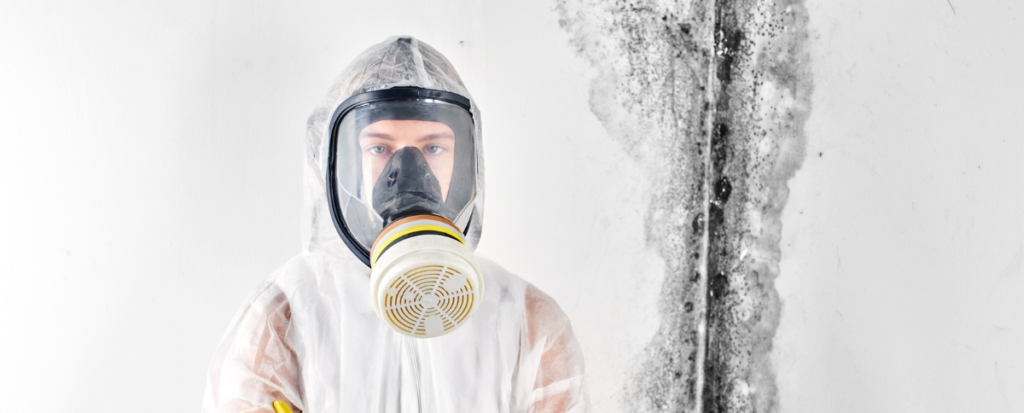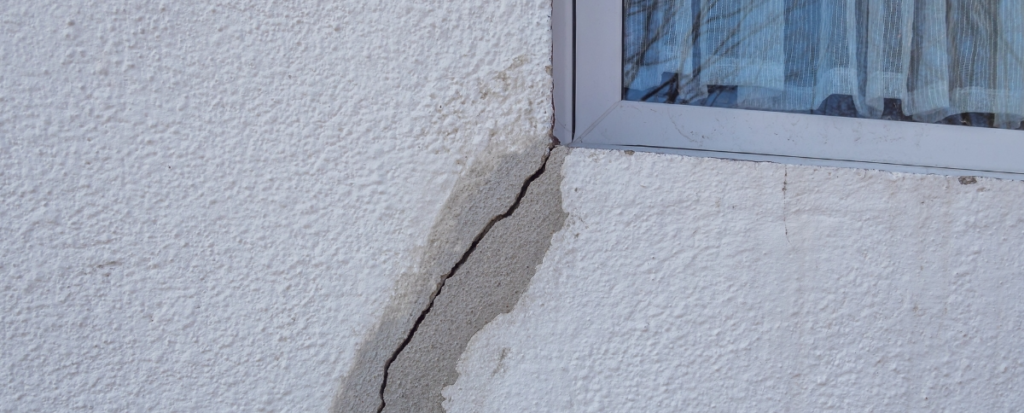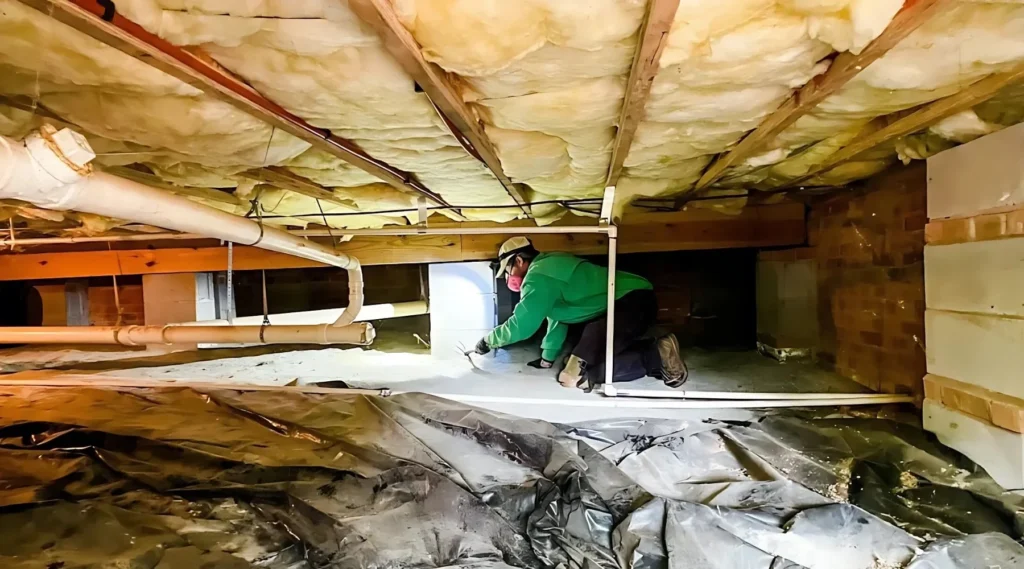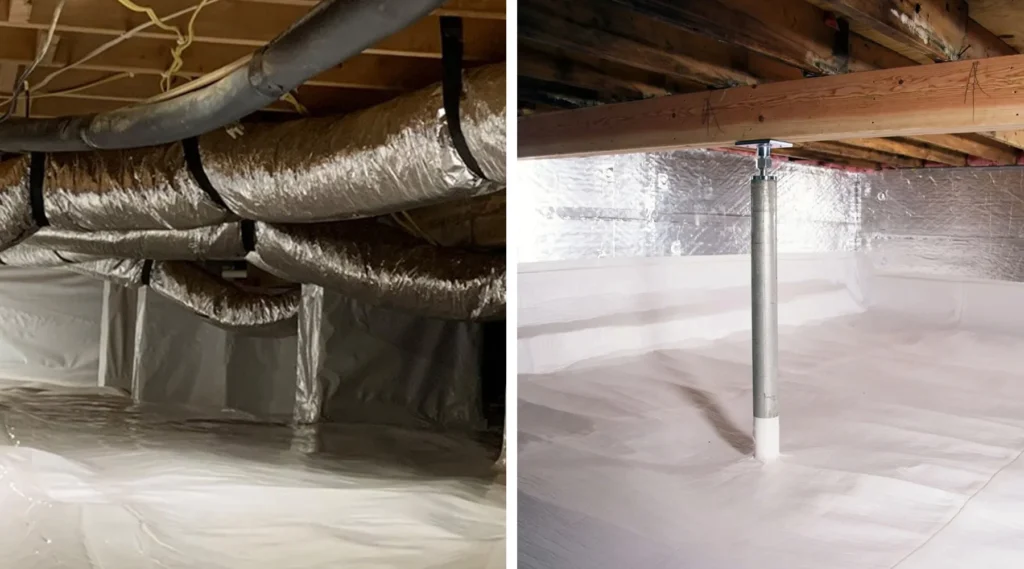White mold in the crawl space is a common fungal growth that thrives in dark, humid environments and can be eliminated through moisture control, proper ventilation, and targeted cleaning with antimicrobial solutions. Unlike black mold, white mold is often less toxic but still poses health risks and can damage wooden structures. Moreover, addressing the underlying moisture problem is crucial for permanent removal.
Therefore, understanding how to remove white mold and prevent its return safely protects both your health and your home’s value. Let’s explore effective methods to eliminate this problem permanently.
What Is White Mold in a Crawl Space?
White mold in crawl space is a fungal growth that appears as white, fuzzy, or powdery patches on wood, insulation, and other organic materials. It’s actually several different types of mold that appear white or light-colored in their early growth stages.
White mold thrives in crawl spaces because these areas provide ideal conditions: darkness, moisture, poor ventilation, and organic materials to feed on. Additionally, crawl spaces often have humidity levels above 60%, which creates perfect growing conditions for mold.
Common types of white mold found in crawl spaces:
- Aspergillus species (appears white when young)
- Penicillium (white to blue-green coloration)
- Cladosporium (can appear white in early stages)
- Chaetomium (white to gray appearance)
- Fusarium (white to pink coloration)
Research from the Environmental Protection Agency shows that 50% of homes have moisture problems that can lead to mold growth. Furthermore, crawl spaces are among the most common locations for mold development.
How Harmful Is White Mold?
White mold can be harmful to both health and property. It grows in damp areas and may cause allergy-like symptoms such as coughing, sneezing, itchy eyes, or skin irritation. For people with asthma or weak immunity, it can be more serious. It also damages wood, furniture, and walls by weakening materials over time.
Why Does White Mold Grow in Crawl Spaces?
High Humidity Levels
Crawl spaces naturally trap moisture, creating ideal conditions for mold growth.
Humidity sources in crawl spaces:
- Ground moisture seeping through dirt floors
- Plumbing leaks from pipes running through the space
- HVAC condensation from ductwork
- Poor ventilation that traps humid air
- Seasonal moisture from rain and snow
- Inadequate vapor barriers on the soil
The CDC recommends keeping indoor humidity below 50% to prevent mold growth. However, crawl spaces often have humidity levels of 70-90% without proper moisture control.
Poor Ventilation
Inadequate air circulation allows moisture to accumulate and stagnate.
Ventilation problems include:
- Insufficient or blocked foundation vents
- Lack of mechanical ventilation systems
- Sealed crawl spaces without proper dehumidification
- Obstructed air flow from stored items
- Inadequate cross-ventilation between vents
Stagnant air prevents moisture from evaporating and creates perfect conditions for mold spores to settle and grow. Additionally, poor ventilation concentrates mold spores in the confined space.
Organic Food Sources
Crawl spaces contain numerous materials that mold can feed on.
Familiar mold food sources:
- Wooden floor joists and subflooring
- Paper-faced insulation
- Cardboard boxes and stored items
- Dust and debris accumulation
- Dead insects and organic matter
- Cotton or natural fiber materials
Mold only needs a small amount of organic material to establish colonies. Moreover, once established, mold can spread rapidly across multiple surfaces.
How Do You Identify White Mold in a Crawl Space?
Visual Signs
White mold has distinctive appearance characteristics that help with identification.
Visual identification features:
- White, gray, or light-colored fuzzy growth
- Cotton-like or powdery texture on surfaces
- Spreading patches that grow over time
- Growth concentrated on organic materials
- Discoloration or staining of affected surfaces
- Visible spores that may appear dusty
White mold often starts small but can cover large areas quickly under favorable conditions. Additionally, it may appear in clusters or spread in irregular patterns.
Smell Indicators
Mold produces distinctive odors that can help identify its presence.
Mold odor characteristics:
- Musty, earthy smell similar to wet soil
- Stale, damp odor that persists
- Stronger smell in humid weather
- An odor that worsens when disturbed
- Sweet or sour undertones in some cases
Trust your nose – if your crawl space smells musty, investigate for mold growth. Furthermore, mold odors often indicate larger colonies than what’s visible on the surface.
Health Symptoms
Exposure to white mold can cause various health symptoms.
Common health effects:
- Respiratory irritation and coughing
- Sneezing and a runny nose
- Eye irritation and watering
- Skin rashes or irritation
- Headaches and fatigue
- Worsening of asthma symptoms
People with allergies, asthma, or compromised immune systems are more sensitive to mold exposure. Additionally, prolonged exposure can worsen symptoms over time.
How Do You Safely Remove White Mold?

Safety Preparation
Proper safety equipment protects you during mold removal.
Essential safety gear:
- N95 or P100 respirator mask
- Safety goggles to protect the eyes
- Disposable gloves (nitrile or rubber)
- Long-sleeved clothing and pants
- Disposable shoe covers
- Plastic sheeting to contain the work area
Never attempt mold removal without proper protection. Additionally, ensure good ventilation during the removal process to prevent spore inhalation.
Cleaning Solutions
Several effective solutions can kill and remove white mold.
Effective mold-killing solutions:
- Bleach solution: 1 cup bleach per gallon of water
- White vinegar: Undiluted white vinegar in spray bottles
- Hydrogen peroxide: 3% solution for organic surfaces
- Borax solution: 1 of cof up borax per gallon of water
- Commercial antimicrobials: EPA-registered mold killers
Test cleaning solutions on small areas first to ensure they won’t damage surfaces. Moreover, never mix different cleaning chemicals as this can create dangerous fumes.
Step-by-Step Removal Process
Follow systematic steps for effective mold removal.
Removal process:
- Isolate the area: Seal off crawl space access to prevent spore spread
- Set up ventilation: Use fans to create air flow during cleaning
- Remove contaminated materials: Dispose of heavily moldy insulation or debris
- Apply cleaning solution: Spray affected surfaces thoroughly
- Scrub surfaces: Use stiff brushes to remove mold growth
- Rinse and dry: Clean with water and ensure complete drying
- Apply preventive treatment: Use antimicrobial solutions to prevent regrowth
Work systematically, from the least contaminated to the most contaminated areas. Additionally, take breaks frequently to avoid overexposure to mold spores.
How Do You Control Moisture to Prevent White Mold?
Ground Moisture Control
Controlling ground moisture is crucial for preventing mold growth.
Ground moisture solutions:
- Vapor barriers: Install 6-mil plastic sheeting over dirt floors
- Concrete sealing: Seal cracks and apply moisture barriers
- Drainage improvement: Install French drains or improve grading
- Waterproofing: Apply foundation waterproofing materials
- Sump pumps: Install in areas prone to water accumulation
Proper vapor barriers can reduce crawl space humidity by 30-50%. Furthermore, they prevent ground moisture from entering the air space.
Ventilation Improvements
Adequate ventilation removes moisture and prevents stagnation.
Ventilation strategies:
- Foundation vents: Ensure proper number and placement of vents
- Mechanical ventilation: Install exhaust fans or ventilation systems
- Cross-ventilation: Create air flow patterns through the space
- Vent maintenance: Keep vents clear of obstructions
- Seasonal adjustments: Open vents in summer, consider closing in winter
The International Residential Code requires 1 square foot of vent area per 150 square feet of crawl space. Additionally, vents should be positioned to create cross-ventilation.
Dehumidification
Mechanical dehumidification provides precise humidity control.
Dehumidification options:
- Crawl space dehumidifiers: Units designed for confined spaces
- Whole-house systems: Integrated with HVAC systems
- Portable units: Temporary solutions for smaller areas
- Automatic controls: Humidity sensors that activate systems
- Drainage systems: Continuous drainage to prevent water buildup
Maintain crawl space humidity below 50% to prevent mold growth. Moreover, dehumidifiers work best in sealed or semi-sealed crawl spaces.
What About Insulation and Structural Damage?

Assessing Insulation Damage
Mold-contaminated insulation often requires replacement.
Insulation assessment factors:
- Extent of contamination: How much insulation is affected
- Type of insulation: Some materials are more salvageable than others
- Structural integrity: Whether insulation is still effective
- Health concerns: Risk of ongoing mold exposure
- Cost considerations: Cleaning versus replacement costs
Fiberglass insulation can sometimes be cleaned if contamination is minimal. However, paper-faced insulation and cellulose typically require replacement when moldy.
Structural Wood Treatment
Wooden structures may need treatment or replacement depending on the severity of damage.
Wood treatment options:
- Surface cleaning: For superficial mold growth
- Sanding: Remove mold penetration in the wood grain
- Antimicrobial treatment: Apply wood preservatives
- Replacement: For severely damaged structural members
- Professional assessment: Structural engineer evaluation for safety
Mold can weaken wood over time by breaking down cellulose fibers. Additionally, some wood species are more resistant to mold damage than others.
Professional Inspection
Consider a professional assessment for extensive damage or structural concerns.
When to call professionals:
- Mold covers more than 10 square feet
- Structural damage is suspected
- Health symptoms persist after cleaning
- Mold returns repeatedly after treatment
- HVAC systems are contaminated
Professional mold remediation companies have specialized equipment and expertise. Furthermore, they can identify hidden mold and moisture sources you might miss.
How Do You Prevent White Mold from Returning?
Long-Term Moisture Management
Permanent mold prevention requires ongoing moisture control.
Prevention strategies:
- Regular inspections: Monthly checks for moisture and mold signs
- Humidity monitoring: Use hygrometers to track moisture levels
- Maintenance schedules: Regular cleaning and upkeep
- Seasonal preparations: Adjust ventilation for weather changes
- Prompt repairs: Fix leaks and moisture problems immediately
Prevention costs far less than repeated mold removal. Additionally, consistent moisture control protects your entire home’s structural integrity.
Crawl Space Encapsulation
Complete encapsulation provides the most effective long-term solution for mold in crawl space.
Encapsulation benefits:
- Complete moisture control: Seals out ground moisture entirely
- Energy efficiency: Reduces heating and cooling costs
- Pest control: Eliminates habitat for insects and rodents
- Storage space: Creates a clean, usable storage area
- Home value: Increases property value and marketability
Encapsulation involves sealing the crawl space completely and conditioning the air. Moreover, it’s often the most cost-effective long-term solution for chronic moisture problems.
Regular Maintenance
Ongoing maintenance prevents minor problems from becoming major issues.
Maintenance checklist:
- Monthly: Check for new moisture sources or mold growth
- Quarterly: Clean and inspect ventilation systems
- Seasonally: Adjust humidity controls and ventilation
- Annually: Professional inspection and system maintenance
- As needed: Address leaks, damage, or changes promptly
Document your maintenance activities to track patterns and identify recurring problems. Additionally, regular maintenance often prevents expensive emergency repairs.
When Should You Call Professionals?
DIY vs. Professional Treatment
Determine when professional help is necessary for safe and effective treatment.
DIY appropriate for:
- Small areas of mold (less than 10 square feet)
- Surface mold on non-porous materials
- Recent mold growth caught early
- Good ventilation and access to affected areas
- No underlying structural damage
Professional help needed for:
- Large mold infestations covering extensive areas
- Mold in HVAC systems or ductwork
- Structural damage or safety concerns
- Health symptoms that persist after cleaning
- Recurring mold problems despite treatment efforts
The EPA recommends professional remediation for mold areas larger than 10 square feet. Additionally, professionals have specialized equipment and training for safe removal.
Choosing Mold Remediation Companies
Select qualified professionals for effective mold treatment.
Qualification criteria:
- Certification: IICRC or similar mold remediation certification
- Insurance: General liability and workers’ compensation coverage
- Experience: Proven track record with crawl space mold
- References: Recent customer testimonials and reviews
- Written estimates: Detailed scope of work and pricing
Get multiple quotes and compare approaches, not just prices. Furthermore, ensure that any contractor follows EPA and industry guidelines for mold remediation.
Conclusion
White mold in crawl spaces is more than just an eyesore; it can affect your health, weaken your home’s structure, and lower property value if left untreated. The key to permanent removal is not only cleaning but also controlling moisture and improving ventilation.
For homeowners who want long-term protection, Tri-State Waterproofing offers professional crawl space solutions, including moisture barriers, encapsulation, and waterproofing systems. With expert help, you can eliminate white mold at its source and keep your home safe, dry, and healthy for years to come.
Frequently Asked Questions
Is white mold in the crawl space dangerous to my health?
White mold can cause respiratory irritation, allergic reactions, and other health symptoms, especially for sensitive individuals. While generally less toxic than black mold, it still poses health risks and should be removed promptly.
Can I just paint over white mold to kill it?
No, painting over mold doesn’t kill it and may actually trap moisture, making the problem worse. Mold must be physically removed, and the underlying moisture problem must be addressed before painting or sealing.
How long does it take to get rid of white mold in a crawl space?
Small areas can be cleaned in a day, but complete remediation, including moisture control, may take several days to weeks. Drying and prevention measures are crucial and shouldn’t be rushed for lasting results.
Will bleach kill white mold permanently?
Bleach can kill surface mold, but doesn’t penetrate porous materials or address root causes. Without moisture control, mold will return. Bleach also doesn’t work well on wood and can damage some materials.
Should I remove all insulation if there’s white mold?
Not necessarily. Lightly contaminated fiberglass insulation can sometimes be cleaned, but paper-faced insulation and heavily moldy materials should be replaced. Professional assessment helps determine what can be salvaged.
How do I know if the white mold is completely gone?
Visual inspection, odor elimination, and air quality testing can confirm successful removal. However, ongoing moisture control and regular monitoring are essential to prevent recurrence in crawl spaces.




